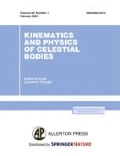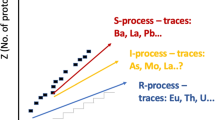Abstract
Many unidentified lines in the spectrum of Przybylski’s star (HD 101065) match well the spectral lines of radioactive elements, including the lines of short-lived isotopes. The origin of such isotopes in the atmosphere of the star remains unknown. We discuss a scenario in which some heavy nuclei of radioactive elements are produced in Przybylski’s star atmosphere as a result of its permanent exposure to the gamma flux (photon-nuclear reactions) or of the direct interaction of the free neutrons which arise in the atmosphere with seed nuclei of lighter elements (r-process). In both cases the gamma quanta and the free neutrons originate due to the presence of the neutron star which forms a close binary system with Przybylski’s star. This neutron star is the source of the fast electrons and positrons which produce gamma quanta when they are decelerated in their interaction with the atomic nuclei of the atmospheric plasma, while free neutrons can originate in the reactions of the direct capture of fast electrons by atmospheric protons (nuclei of hydrogen atoms).
Similar content being viewed by others
References
Burbidge, E.M. and Burbidge, G.R., Nucleosynthesis in Galaxies, Essays in Nuclear Astrophysics, Barnes, C.A., Clayton, D.D., and Schramm, D.N., Eds., Cambridge: Cambridge Univ., pp. 22–32.
Ginzburg, V.L., Teoreticheskaya fizika i astrofizika (Theoretical Physics and Astrophysics), Moscow: Nauka, 1987.
Doroshkevich, A.G., Efremov, Yu.A., Zasov, A.V., et al., Proiskhozhdenie i evolyutsiya galaktik i zvezd (Origin and Evolution of Galaxies and Stars), Moscow: Nauka, 1976.
Kontorovich, V.M. and Flanchik, A.B., On the Relationship between Gamma Radiation and Radio Radiation in Pulsars, Pis’ma v ZhETF, 2007, vol. 85, no. 6, pp. 323–327.
Kuzmichev, V.E., Zakony i formuly fiziki (Laws and Formulas of Physics), Kyiv: Naukova Dumka, 1989.
Lang, K.R., Astrophysical Formulae, Berlin: Springer, 1974.
Manchester, R.N. and Taylor, J.H., Pulsars, San Francisco: W.H. Freeman, 1977.
Radtsig, A.A. and Smirnov, B.M., Parametry atomov i ionov (Parameters of Atoms and Ions), Moscow: Atomizdat, 1986.
Frenkel’, Ya.I., Printsipy teorii atomnykh yader (Concepts of the Theory of Atomic Nuclei), Moscow: Akad. Nauk SSSR, 1950.
Khokhlova, V.L., Magnetic Stars, Itogi nauki i tekhniki. Astronomiya (Advances in Science and Engineering. Astronomy), Moscow: VINITI, 1983, vol. 24, pp. 233–289.
Shavrina, A.V., Polosukhina, N.S., Pavlenko, Ya.V., et al., Peculiarities in the Spectrum of the Unique roAp Star HD 101065 in the Region of the Lithium Resonance Doublet Line 6708 A, Astron. Zhurn., 2003, vol. 80, no. 7, pp. 538–544.
Shavrina, A.V., Khalak, V.R., Mikhailitskaya, N.G., and Polosukhina, N.S., Taking into Account the Magnetic Splitting of Lines in the Determination of Lithium Abundance in the Atmosphere of the roAp Star HD 101065, Kinematika i Fizika Nebes. Tel, 2004, vol. 24, no. 1, pp. 43–52.
Bidelman, W.P., Tc and Other Unstable Elements in Przybylski’s Star, ASP Conf. Ser., 2005, vol. 336, pp. 309–311.
Bidelman, W.P. and Keenan, P.C., The Ba II-Stars, Astrophys. J., 1951, vol. 114, no. 1, pp. 473–476.
Briquet, M., Hubrig, S., De Cat, P., et al., On the Co-Existence of Chemically Peculiar Bp Stars, Slowly Pulsating B Stars and Constant B Stars in the Same Part of the H-R Diagram, Astron. and Astrophys., 2007, vol. 466, no. 1, pp. 269–276.
Burbidge, G.R., On the Anomalous Element Abundances of Magnetic Stars, Stellar and Solar Magnetic Field, Proc. IUA-1965 Symp. no. 22, Munchen, 1965, pp. 418–419.
Cowley, C.R., Bidelman, W.P., Hurbig, S., et al., On the Possible Presence of Promethium in the Spectra of HD 101065 (Przybylski’s star) and HD 965, Astron. and Astrophys., 2004, vol. 419, no. 3, pp. 1087–1093.
Cowley, C.R. and Hubrig, S., The Calculation Isotopic Anomaly in Magnetic CP Stars, Astron. and Astrophys., 2005, vol. 432, no 1, pp. 21–24.
Cowley, C.R., Hubrig, S., Castelli, F., et al., Heavy Calcium in CP Stars, Mon. Notic. Roy. Astron. Soc., 2007, vol. 377, no. 4, pp. 1579–1587.
Cowley, C.R. and Mathys, G., Line Identifications and Preliminary Abundances from the Red Spectrum of HD101065 (Przybylski’s Star), Astron. and Asrtrophys., 1998, vol. 339, no 1, pp. 165–169.
Cowley, C.R., Ryabchikova, T., Kupka, F., et al., Abundances in Przybylski’s Star, Mon. Notic. Roy. Astron. Soc., 2000, vol. 317, no. 1, pp. 299–309.
Gopka, V., Yushchenko, A., Goriely, S., et al., Radioactive Elements in Stellar Atmospheres, International Symposium on Origin of Matter and Evolution of Galaxies 2005: New Horizone of Nuclear Astrophysics and Cosmology, Tokio, Japan, 8–11 November, 2005, AIP Conf. Proc., vol. 843, pp. 389–391.
Gopka, V., Yushchenko, A., Musaev, F., et al., Stellar Abundance Patterns. What Is the Possible Level of Completeness Today?, IAUS (Proc. 210th Symp. of IAU, Uppsala, Sweden, 17–21 June, 2002), Peskunov, N., Weiss, W., Gray, D.F.D., Eds., 2003, vol. 210, p. E5.
Gopka, V., Yushchenko, A., Shavrina, A., et al., On The Radioactive Shells in Peculiar Main Sequence Stars: the Phenomenon of Przybylski’s Star, The A-Star Puzzle (IAU Symp. Poprad, Slovakia), 2004, vol. 224, pp. 119–127.
Goriely, S., Nucleosynthesis by Accelerated Particle to Account for the Surface Composition of HD101065, Astron. and Astrophys., 2007, vol. 466, no. 2, pp. 619–626.
Hubrig, S., Kurtz, D.W., Banulo, S., et al., Measurements of Magnetic Fields over the Pulsation Cycle in Six roAp Stars with FORS 1 at the VLT, Astron. and Astrophys., 2004, vol. 415, no. 1, pp. 661–669.
Kouveliotou, C., Strohmayer, T., Hurley, K., et al., Discovery of a Magnetar Associated with the Soft GAMMA Repeater SGR 1900+14, Astrophys. J., 1999, vol. 510, no. 2, pp. L115–L118.
Kuchowicz, B., The Peculiar a Stars and the Origin of the Heaviest Chemical Elements, Quart. J. Roy. Astron. Soc., 1973, vol. 14, no. 2, pp. 21–140.
Kurtz, D.W., 12.15 Minute Light Variations in Przybylski’s Star, HD101065, Inform. Var. Stars., 1978, no. 1436, pp. 1–2.
Kurtz, D.W. and Wegner, G., The Nature of Przybylski’s Star: An Ap Star Model Infrared from the Light Variations and Temperature, Astrophys. J., 1979, vol. 232, pp. 510–519.
Martinez, P. and Kurtz, D.W., Observations of Pulsating Ap-stars in South Africa, Astrophys. and Space Sci., 1995, vol. 230, no. 1–2, pp. 29–39.
McClure, R.D., Fletcher, J.M., Nemec, J.M., The Binary Nature of the Barium Star, Astrophys. J., 1980, vol. 238, no. 2, pp. 35–38.
Mkrtichian, D.E. and Hatzes, A.P., HD101065, the Most Peculiar Star: High Resolution Spectroscopic Results, J. Astrophys. and Astron., 2005, vol. 26, pp. 185–191.
Perryman, M.A.C., Lindegren, L., Kovalevsky, J., et al., The Hipparcos Catalogue, Astron. and Astrophys., 1997, vol. 323, no. 1, pp. L49–L52.
Przybylski, A., A G0 Star with High Metal Content, Nature, 1961, vol. 189, no. 4766, pp. 739.
Przybylski, A., Line of Holmium in the Spectrum of HD 101065, Acta Astron., 1963, vol. 13, no. 4, pp. 217–228.
Przybylsky, A., Can the Peculiarities of the HD 101065 be Explained by Fission of Transuranium Elements, Proc. Astron. Soc. Austral., 1975, vol. 2, pp. 352–353.
Przybylski, A., Is Iron Present in the Atmosphere of HD 101065?, Mon. Notic. Roy. Astron. Soc., 1977, vol. 178, no. 1, pp. 71–84.
Przybylski, A. and Kennedy, M., The Spectrum of HD 101065, Publs Astron. Soc. Pacif., 1963, vol. 75, no. 445, pp. 349–354.
Ruderman, M.A. and Sutherland, P.G., Theory of Pulsars: Gaps, Sparks, and Coherent Microwave Radiation, Astrophys. J., 1975, vol. 196, no. 1, pp. 51–72.
Shavrina, A.V., Polosukhina, N.S., Khan, S., et al., Lithium and Li6–Li7 Isotope Ratio in the Atmospheres of Some Sharp-Lines roAp Stars, Astron. Rept., 2006, vol. 50, no. 6, pp. 500–511.
Shavrina, A.V., Polosukhina, N.S., Tsymbal, V.V., et al., Quantative Analysis the Spectrum of the Magnetic roAp Star HD 83368 with “Lithium” Spots, Astron. Rept., 2000, vol. 44, pp. 235–245.
Wegner, G., Cummis D.J., Byrne, P.B., and Stickland D.J., Element Identification in the Ultraviolet Spectrum of HD 101065, Astrophys. J., 1983, vol. 272, no. 1, pp. 649–659.
Wegner, G. and Petford, A.D., Abundance Analysis of Przybylski’s Star (HD 101065), Mon. Notic. Roy. Astron. Soc., 1974, vol. 168, no. 3, pp. 557–575.
Wolf, S.C. and Hagen, W., The Magnetic Field of HD 101065, Publs Astron Soc. Pacif., 1976, vol. 88, pp. 119–121.
Yushchenko, A., Gopka, V., Goriely, S., et al., About the Possibility of Explanation of the Spectrum of Przybylski’s Star by the Lines of Radioactive Elements, Nuclei in Cosmos. IX, Proc. Science, International Symp. on Nuclear Astrophysics, CERN, Switzerland, 25–30 June, 2006, pp. 198–204.
Yushchenko, A., Gopka, V., Kim, C., et al., Chemical Abundances Patterns for Sharp-Lined Stars, J. Korean Astron. Soc., 2002, vol. 35, pp. 209–220.
Author information
Authors and Affiliations
Corresponding author
Additional information
Original Russian Text © V.F. Gopka, O.M. Ul’yanov, S.M. Andrievskii, 2008, published in Kinematika i Fizika Nebesnykh Tel, 2008, Vol. 24, No. 1, pp. 50–60.
About this article
Cite this article
Gopka, V.F., Ul’yanov, O.M. & Andrievskii, S.M. A hypothesis for explaining the origin of Przybylski’s star (HD 101065). Kinemat. Phys. Celest. Bodies 24, 36–43 (2008). https://doi.org/10.1007/s11963-008-1005-7
Received:
Published:
Issue Date:
DOI: https://doi.org/10.1007/s11963-008-1005-7




